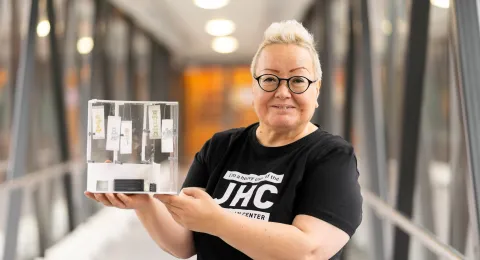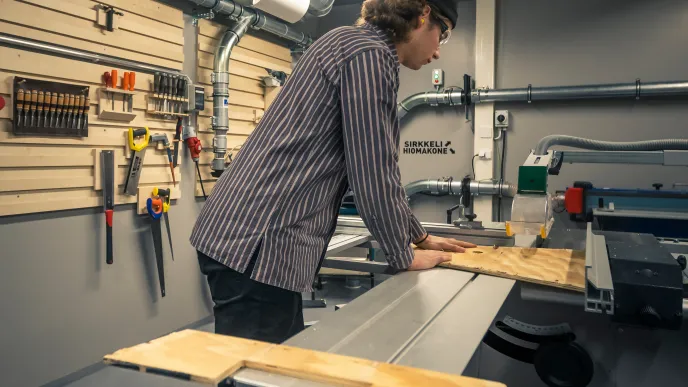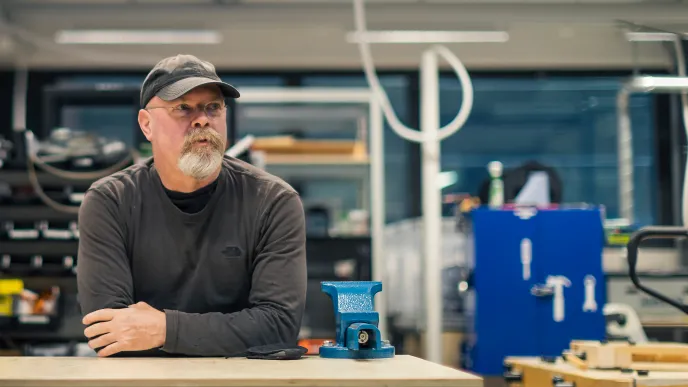1 Wooden machines by students
In 2023, the J. Hyneman Center (JHC) celebrated its fifth anniversary. To mark this milestone, the prototyping lab, in collaboration with the Association of Finnish Wood Industries, announced a new building challenge, where students from the LUT academic community created wooden machines.
The winner, Philipp Grube, won the JHC Anniversary Building Challenge with his Wooden Dough Machine (WDM). Grube is an ERASMUS student from Germany and studies computer engineering.
“The WDM was a very well-conceived and executed project, and the builder should be commended for turning out something that is a prototype but approaches a level of an actual manufactured and saleable product,” the jury says.
Grube received a prize of 1,000 euros. You can read more about the winner and the Wooden Dough Machine here.
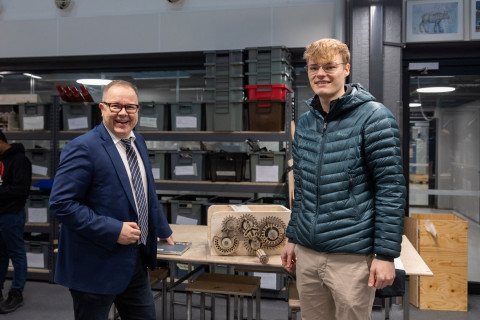
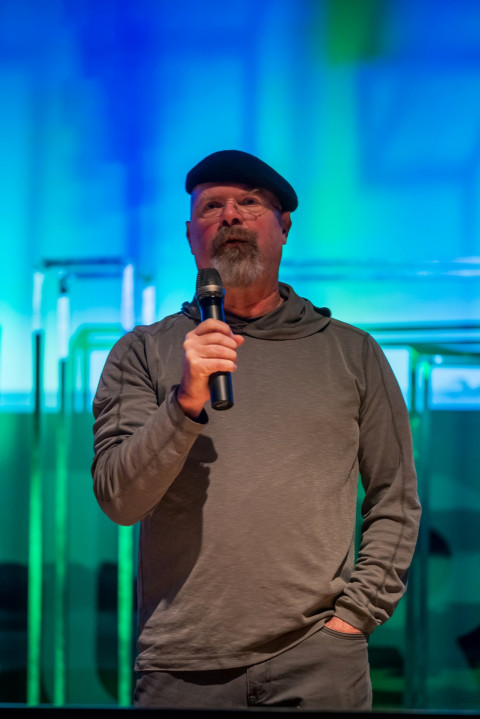
2 A word from Jamie: Innovations and sustainability
(A summary of a lecture at the Lappeenranta campus, Viipuri Hall, on November 18, 2023)
“When talking about the JHC, one small scale example of our sustainability actions is Hynebot, a telepresence robot. We have two Hynebots, one in my workshop back in the USA and one here on the Lappeenranta campus.
I want to be part of the JHC’s day-to-day-life, but flying between Finland and USA, where I live, causes huge carbon dioxide emissions – approximately over 2,000 tons per round trip. So, originally Hynebot was invented to enable easy communication between myself and the JHC staff.
Using Zoom, for example, for meetings, is like watching zombies or mugshots of people. With Hynebot I can see people’s emotions and reactions. Hynebot is made from wood – plywood to be exact – and wood is a popular material at the JHC. Of course, we also consider the origins and that the wood we use is sustainably harvested.
We also had a construction challenge for students: in collaboration with the Association of Finnish Wood Industries, we challenged students from LUT Universities to brainstorm and build wooden machines.
So, you need to believe that small steps make a big difference.”
Jamie Hyneman, inventor, professor of practice
3 An art project: ”Sometimes all it takes is a good idea”
“Art students have some prejudices towards technology; it somehow intimidates them. However, the JHC is easy to approach. There's always someone there to help, and you don't have to know everything yourself. The LAB University of Applied Sciences is introducing a mandatory IT course for first-year fine arts students, which includes a course at the JHC. I think it's a really great change.
As for me, I want to learn how to use the JHC's equipment precisely because I can make use of similar machines in my future art projects. For example, last spring, I used the JHC's laser to create a woodcut print for the JHC Spring Seminar. As the model, I used an old photograph featuring my late father proudly sitting on his motorcycle. I engraved the plywood block with the JHC's laser engraver. I used it to make a woodblock print on washi paper.
My interest in technology led me to inquire about an internship at JHC. Head of Development, Marko Kasurinen, responded jokingly responded by asking what they would get in return. We ended up agreeing that I'd do my final project in the JHC's facilities, creating an artwork that will be hung from the workshop’s ceiling (miniature of the artwork in the main image of this article).
The title of the artwork is "Sometimes all it takes is a good idea". The material is linen, on which I’ll print structural drawings from the JHC's past and ongoing projects. I met Jamie Hyneman when he visited the Lappeenranta campus in October. He was a great help in brainstorming material choices."
Minja Kautiainen, art student, LAB University of Applied Sciences
See Kautiainen’s art on Instagram @inkyminsky.
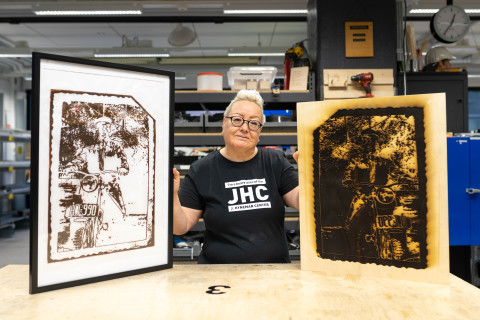
Photo: Aaro Rouhiainen
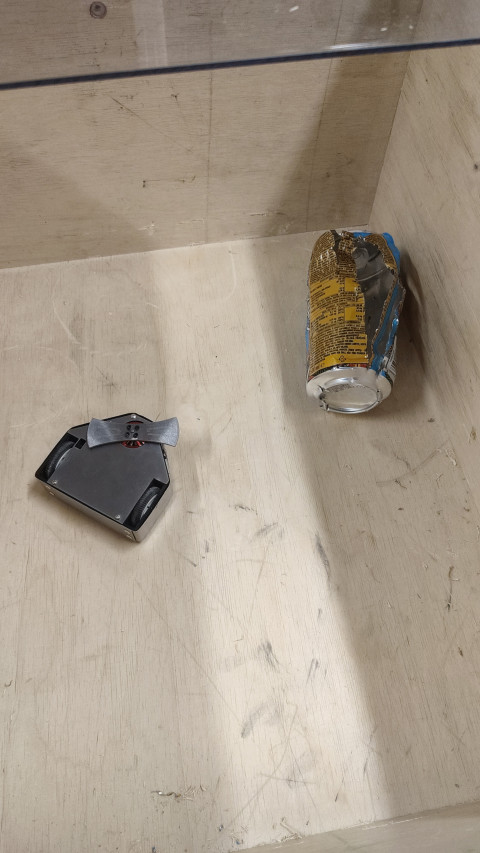
5 Small combat robots to develop engineering skills
Combat robot refers to the entire sport worldwide. Two robots battle against each other on an arena either to disable the opponent or knock it into one of the pits to win the round.
The purpose of the combat robot project is for engineering students to develop strong skills in many areas of engineering – especially modeling – in a fun and competitive way. This competitiveness should drive the teams to constantly improve on their design and hopefully win the tournament.
There are many different weight classes ranging from 150 grams up to 125 kilograms. We use the smallest size, 150 grams, which has been another great way to challenge everyone’s designing skills. Designing robots this small and light needs a lot of consideration to really utilize the material.
However, they can be made in any way from any material if they are under the weight limit and follow the rules. I personally chose to print the frame from nylon on a 3D printer and used thin steel for the armor.
There are strict rules to follow revolving around this and safety is something that always comes first. We are following the rules set by the Finnish Combat Robotics Community Robotsota, which align with the rules followed by most robotics combat organizations around the world.
We are currently constructing our own arena and will hold a small tournament with the teams involved in the project at the end of the semester, if all goes well. We have already made a test box, which is used for testing any weapon systems the teams have designed.
The goal is to open this up to anyone who's interested, and hopefully get others involved as well.”
Jethro McLean, junior research assistant, LUT
6 JHC Ukkonen dropped 63 kilos
Some may have wondered why LUT’s electric motorcycle, JHC Ukkonen, was not seen at the Imatranajo races in July. One major reason was that during the programming of the controller's EEPROM parameters (electrically erasable programmable read-only memory), the software lost the hardware version information. This caused measurement errors in voltages and internal temperatures, which, in turn, triggered protections and prevented the controller from functioning.
Cooperating with the controller manufacturer to diagnose the issue took a few days, which left no time for testing. Consequently, there was no choice but to skip Imatranajot. Additionally, rainy weather plagued the entire race weekend, preventing the track from drying completely. To minimize risks, Ukkonen is not driven on a wet track.
After the summer holidays, the issue with the controller was quickly resolved thanks to the calibration instructions provided by the controller manufacturer. Although the exact cause of the programming problem was never determined, the bike has been carefully fine-tuned and adjusted throughout the autumn.
The first tuning session was successfully conducted at AMW Dynoservice, and based on the observations made there, various adjustments were made, including field weakening, power limits, and different speed restrictions. The results obtained are very promising, considering that the current version of the bike is 63 kilograms lighter than the previous one.
Marko Kasurinen, head of development, designer of JHC Ukkonen, LUT
7 Record number of student projects presented at the JHC Spring Seminar
The JHC Spring Seminar showcased a record number of prototypes last year, a total of 39.
The annual spring seminar is the culmination of the prototype workshop’s activities where students can exhibit their course assignments. The seminar has attracted hundreds of visitors, including partners such as representatives of the Heureka Science Centre.
The seminar entries included projects with obvious potential for practical use, such as a solar panel cleaner or an electric shopping cart.

